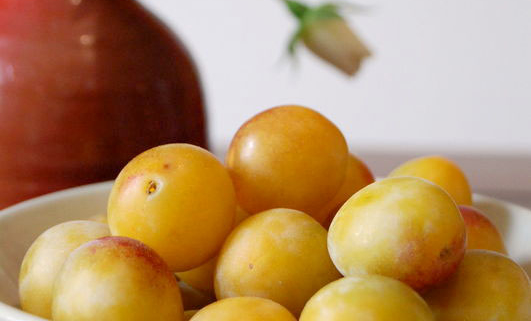Time for mirabelles
When summer decides that it’s over in the south of France, it doesn’t fool around. For a few days last week, it was as if someone with a wicked sense of humor was aiming a giant firehose at the city of Nice. Local artist Sylvie T.’s mother, who delights in chatting with passers-by in front of her Old Town gallery, put it more poetically. “In Nice it doesn’t rain; it’s the sun that’s crying.”
The tomatoes are no longer as sweet, eggplants are on their way out and peaches are ancient history (even if there are still some imposters at the market stalls), but unlike the capricious sun I’m still finding reasons to stay cheerful. First among these are mirabelles, little yellow plums with a pink blush that appear at the market for no more than six weeks every year. I first spotted them this year at the Paris markets in early September, and was not surprised to see them pop up in various guises wherever I turned: when a fruit has a season this brief, no cook can resist it.
Mirabelles, like their cousin the quetsch (known as damson in English), are a specialty of the Alsace-Lorraine region. It’s thought that René of Anjou discovered them during the Crusades of the 15th century – if he was anything like me, he ate them like popcorn and refused to share. I’ve tasted mirabelles grown in the Nice area but I can’t deny that the sweetest, most golden fruit comes from Metz, its original French home. These mirabelles are recognizable by their size – hardly bigger than a cherry – and their honey-like sweetness balanced by a touch of acidity. Mirabelles from Nancy are bigger, more uniformly yellow and slightly less subtle tasting.
In Paris, I came across mirabelles encased in dark chocolate at Jean-Charles Rochoux, whose friendly young owner produces a different fruit-filled chocolate bar every Saturday to be eaten within a day or so. Cooking teacher Paule Caillat combined them with figs in a rich almond-cream tart flavored with kirsch, using her signature pastry (mirabelles love anything eggy and make a wonderful clafoutis). And at the Marais bistro Le Gaigne, I tasted a simple but unusual dessert of mirabelles poached in rosemary syrup that I instantly vowed to recreate at home.
The only difficult thing about this dessert proved to be making it before I had absent-mindedly eaten all the mirabelles. It turned out to be worth the self-restraint, the herbal quality of the rosemary balancing the sweetness of the sugar-honey syrup and of the fruit itself. I can imagine that it might taste even better with a scoop of rosemary-infused sorbet – or, more simply, vanilla ice cream.
Mirabelles in rosemary syrup
Serves 4
11 oz mirabelles, pitted and halved (300 g)
1 1/4 cups water (300 ml)
4 oz vanilla sugar* or white sugar
1 tbsp mild tasting honey, such as lavender
1 sprig of rosemary
In a medium saucepan, stir together the water, sugar and honey with the rosemary. Bring to a boil, lower the heat and simmer for 5 mins. Add the mirabelles, turn the heat down to barely a simmer and poach for 5-10 mins, until soft. Turn off the heat and allow to cool before eating.
* I make vanilla sugar by washing off vanilla pods that I have used for another purpose, drying them and adding them to a jar that I keep filled with sugar. The taste is rather subtle, but the smell is sublime.


 Paquerettes
Paquerettes
I am so excited to have found this blog! I’ve been living in Nice since September with a French professor I met in Canada — and I’ve been trying to figure out what to eat here as a woman with many Canadian eating habits! There’s so much great food in Nice — it’s wonderful to finally have found another Canadian to explain it all. (Some of my less successful French food experiments are my blog at http://www.kerrymacgregor.com)
Kerry
Yummm sounds great. I wish there were mirabelles in New England! Hope all is well in the South
I know what you mean, Joy! I suppose I am spoiled with all the fruit we have at the market, but mirabelles are finished already! Sob.
What’s wrong with me, Rosa…I find it very difficult to cook perfectly good & ripe summer fruits. My dream is to have produce coming out of my garden so I’ll have such bounty I wouldn’t know what else to do but cook them. Your recipe sounds wonderful!
That’s interesting Beth, I’ve never heard of a pluot! We had such a hot summer here in Nice that for once in my life I was anxious for fall to arrive. That must be why I’m welcoming the mirabelles, apples and pears!
The mirabelles look lovely. Here in California it’s pluot season, a cross between an apricot and plum with a plum-like dappled skin. Growers are also at the farmers markets with some late varieties of peaches and nectarines. I made a peach cobbler yesterday which I served with dollops of my freshly whipped cream. Somehow I can’t get quite as excited about the incoming crops of Fall apples…there’s something about that summer fruit, delicious and thirst-quenching at the same time!